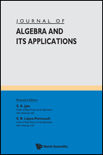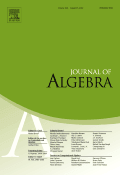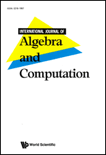
International Electronic Journal of Algebra
Scope & Guideline
Elevating Algebraic Discourse in the Global Community
Introduction
Aims and Scopes
- Module Theory:
A significant portion of the journal's articles focuses on module theory, exploring various types of modules, their structures, and properties. This includes studies on special classes of modules, such as projective, injective, and flat modules. - Algebraic Structures:
The journal extensively covers research on different algebraic structures, including rings, fields, groups, and algebras. This encompasses the analysis of their properties, classifications, and interrelations. - Homological Algebra:
There is a strong emphasis on homological methods and their applications in algebra, particularly in the study of derived categories, syzygies, and cohomology theories. - Commutative Algebra:
Research related to commutative rings and their ideals is prevalent, focusing on topics such as zero-divisor graphs, ideals in polynomial rings, and properties of specific classes of rings. - Group Theory:
The journal features articles related to group theory, particularly on finite groups, their representations, subgroup structures, and applications in algebraic contexts. - Applications of Algebra:
The application of abstract algebraic concepts in various fields such as computational methods, coding theory, and combinatorics is also a notable focus area.
Trending and Emerging
- Advanced Module Theory:
There is an increasing interest in advanced topics within module theory, including the study of special types of modules, such as pseudo-absorbing modules and strongly graded modules, which reveal new insights into module structures. - Computational Algebra:
The rise of computational methods in algebra has led to a growing number of publications focused on algorithms and computational techniques for analyzing algebraic structures and solving algebraic problems. - Graph Theory and Algebra:
The intersection of graph theory and algebra, particularly through the exploration of zero-divisor graphs and their properties, is becoming a prominent theme, highlighting the interplay between these disciplines. - Homological Methods:
The application of homological algebra techniques is trending upward, particularly in the context of derived categories and their implications for understanding the structure of various algebraic entities. - Categorical Algebra:
Emerging research is increasingly focused on categorical approaches to algebra, exploring equivalences of categories and their applications to various algebraic structures, indicating a shift towards more abstract and generalized frameworks.
Declining or Waning
- Classical Algebra:
Topics focused on classical algebraic concepts, such as basic polynomial equations and elementary group theory, appear to be less prevalent, possibly overshadowed by more complex and specialized studies. - Elementary Number Theory:
Research in elementary number theory, which once had a more substantial representation, is becoming less common in favor of more abstract algebraic structures and their applications. - Finite Field Applications:
While still relevant, the specific applications of finite fields in coding theory and cryptography have seen a decrease, as research shifts toward more generalized algebraic frameworks. - Algebraic Geometry:
Although related fields like commutative algebra remain strong, direct studies in algebraic geometry seem to be waning, with fewer publications dedicated to this area. - Noncommutative Algebra:
There appears to be a reduced focus on certain aspects of noncommutative algebra, particularly in comparison to the growing interest in modules and homological dimensions.
Similar Journals

Journal of Combinatorial Algebra
Connecting Minds in Discrete Mathematics and Number TheoryThe Journal of Combinatorial Algebra, published by the European Mathematical Society (EMS), is a pioneering open-access journal dedicated to advancing research in the fields of Algebra and Number Theory, as well as Discrete Mathematics and Combinatorics. Since its inception in 2018, the journal has been committed to promoting high-quality, rigorous research, evidenced by its 2023 scopus rankings placing it in the second quartile across both disciplines. It serves as a vital platform for academics, researchers, and students to share innovative findings, methodologies, and theoretical advancements within combinatorial algebra, facilitating collaboration and knowledge dissemination in the mathematical community. With its open access policy adopted in 2021, the journal ensures that its content is freely available to a global audience, further enriching the landscape of mathematical research. The journal's editorial board, composed of leading experts, guarantees the integrity and academic excellence of published articles, making it an essential resource for those engaged in the dynamic fields of combinatorics and algebra.

International Journal of Group Theory
Fostering Collaboration in Mathematical InnovationThe International Journal of Group Theory, published by UNIV ISFAHAN, VICE PRESIDENT RESEARCH & TECHNOLOGY, serves as a vital platform for researchers, professionals, and students engaged in the fields of algebra and number theory. Established in 2012, this Open Access journal allows unrestricted access to its contents, fostering knowledge sharing and collaboration among the mathematical community. The journal holds a Q3 category ranking in the field of Algebra and Number Theory as of 2023 and is placed in Scopus's Mathematics rankings, reflecting its commitment to advancing mathematical research. With a focus on group theory and its applications, the International Journal of Group Theory aims to publish high-quality research articles, review papers, and short communications that contribute to theoretical developments as well as practical implementations. This journal is an essential resource for anyone looking to stay updated on the latest trends and findings in algebraic structures and their interdisciplinary applications, with its archives running from 2012 through 2025, ensuring a comprehensive repository of knowledge.

MICHIGAN MATHEMATICAL JOURNAL
Unveiling New Perspectives in Mathematics Since 1996The MICHIGAN MATHEMATICAL JOURNAL is a prestigious and influential publication in the field of mathematics, founded by the University of Michigan. With an ISSN of 0026-2285 and an E-ISSN of 1945-2365, this journal is recognized for its high-quality research and has achieved a commendable Q1 ranking in the category of Mathematics (miscellaneous) as of 2023. Published by the esteemed Michigan Mathematical Journal, it provides a platform for the dissemination of innovative mathematical theories and findings, playing a crucial role in advancing knowledge and scholarship within the mathematical community. With coverage spanning from 1996 to 2024, the journal emphasizes rigorous theoretical development and fosters collaboration among researchers, professionals, and students alike. While not an open-access journal, its contributions are invaluable for those looking to stay abreast of cutting-edge mathematical research.

ALGEBRA UNIVERSALIS
Elevating Logic through Rigorous ScholarshipALGEBRA UNIVERSALIS is a prestigious academic journal published by Springer Basel AG, dedicated to the exploration and advancement of mathematical research, particularly within the realms of algebra, number theory, and logic. Established in 1971, this journal continues to provide a platform for innovative research and discourse, contributing significantly to its fields of study over more than five decades. With its current classification in the Q2 quartile for both Algebra and Number Theory and Logic, ALGEBRA UNIVERSALIS ranks prominently within the mathematical community. Although it is not an open-access journal, it offers numerous subscription options for individuals and institutions seeking to stay current with the latest developments and findings. The journal’s commitment to quality research makes it an essential resource for researchers, professionals, and students aiming to deepen their understanding and knowledge of advanced mathematical theories and methodologies.

JOURNAL OF ALGEBRA AND ITS APPLICATIONS
Exploring the Frontiers of Algebra and Its ApplicationsJOURNAL OF ALGEBRA AND ITS APPLICATIONS, published by WORLD SCIENTIFIC PUBL CO PTE LTD, stands as a pivotal resource for scholars in the fields of Algebra and Applied Mathematics. With an ISSN of 0219-4988 and E-ISSN 1793-6829, this journal has been providing a forum for the dissemination of cutting-edge research since its inception in 2008, converging towards a forward-looking timeline extending to 2024. As of 2023, it has earned a commendable Q2 ranking in both Algebra and Number Theory, as well as Applied Mathematics, reflecting its solid impact within the mathematical community. With a Scopus rank of #49/119 in Algebra and Number Theory, and #420/635 in Applied Mathematics, the journal captures significant advancements and applications across various mathematical domains. While it does not operate under an open access model, its comprehensive articles and research outputs are crucial for fostering intellectual dialogue and innovation in academia. Researchers, professionals, and students alike will find this journal an indispensable asset for their scientific pursuits and explorations into the vast field of mathematics.

Electronic Journal of Linear Algebra
Unveiling the Dynamics of Linear Algebra Applications.The Electronic Journal of Linear Algebra, published by the International Linear Algebra Society, is a pivotal platform for research and discourse in the field of linear algebra. With an ISSN of 1537-9582 and an e-ISSN of 1081-3810, this esteemed journal has been disseminating cutting-edge findings since its inception in 1996 and will continue through to 2024. Situated in the United States, at the University of West Florida, the journal has garnered recognition within the academic community, reflected in its Q2 quartile status in Algebra and Number Theory as of 2023, alongside a respectable Scopus rank of #62 out of 119. Although it operates as a non-open access journal, the Electronic Journal of Linear Algebra offers valuable insights and innovative approaches, fostering the development of linear algebra theory and its applications, making it a crucial resource for researchers, professionals, and students alike.

JOURNAL OF ALGEBRA
Illuminating the Path of Algebraic InnovationThe JOURNAL OF ALGEBRA, published by Academic Press Inc. Elsevier Science, is a premier scholarly outlet dedicated to the field of algebra and number theory. With its impressive Q1 ranking in the 2023 category of Algebra and Number Theory and a solid Scopus rank of #46 out of 119, it stands as a crucial resource for researchers and professionals seeking to deepen their understanding of advanced algebraic concepts. Operating since 1964 and continuing through 2025, the journal boasts a rich history of publishing influential research that drives the discipline forward. While the journal does not currently offer open access options, it remains committed to providing high-quality peer-reviewed content to the academic community. Its comprehensive archive and cutting-edge research articles serve as essential tools for students, researchers, and practitioners aiming to stay at the forefront of algebraic studies.

INTERNATIONAL JOURNAL OF ALGEBRA AND COMPUTATION
Fostering Interdisciplinary Connections in MathematicsThe INTERNATIONAL JOURNAL OF ALGEBRA AND COMPUTATION, published by WORLD SCIENTIFIC PUBL CO PTE LTD, is a prominent platform in the field of mathematics, specifically focusing on algebraic structures and computational methods. With a publication history dating back to 1996 and converging to 2024, this journal has established a significant presence within the academic community, as reflected in its Q2 category ranking in Mathematics and its position in the Scopus 45th percentile for General Mathematics. Although it does not offer Open Access, researchers can access a wealth of original research articles, comprehensive reviews, and groundbreaking findings that contribute to the advancement of mathematical theory and its applications. This journal not only serves as an invaluable resource for mathematicians but also encourages interdisciplinary research by appealing to professionals and students alike who seek to deepen their understanding of algebra and computation methodologies.

Algebra & Number Theory
Advancing the Frontiers of Algebra and Number TheoryAlgebra & Number Theory, published by Mathematical Science Publications, stands at the forefront of mathematical research, particularly in the fields of algebra and number theory. With an ISSN of 1937-0652 and E-ISSN 1944-7833, this esteemed journal provides a dedicated platform for the dissemination of cutting-edge theoretical advances and practical applications. It has achieved a Q1 category ranking in both algebra and number theory according to the 2023 quartiles, reinforcing its critical role in shaping contemporary mathematical discourse. The journal serves as an essential resource for researchers, professionals, and students alike, offering insights into diverse mathematical methodologies and fostering open dialogue among scholars. Although it does not provide open access, its robust impact factor reflects the high quality and relevance of its published work. Based in the United States at the University of California, Berkeley, the journal's commitment to excellence continues to attract contributions that push the boundaries of mathematical understanding.

New York Journal of Mathematics
Connecting researchers to shape the future of mathematics.New York Journal of Mathematics is a prominent open-access journal, published by the ELECTRONIC JOURNALS PROJECT, dedicated to advancing the field of mathematics through the dissemination of groundbreaking research. Since its inception in 1996, the journal has evolved into a valuable resource for researchers, educators, and students, particularly in the realm of general mathematics. As of 2023, it proudly holds a Q2 classification in the Mathematics (miscellaneous) category, reflecting its growing impact and reach within the academic community, despite being ranked at the 31st percentile overall. With its commitment to open access since 2022, the journal ensures that high-quality mathematical research is readily available to a global audience, fostering collaboration and innovation. Researchers interested in contributing to this dynamic field will find the journal a vital platform for sharing their findings and engaging with fellow mathematicians around the world.